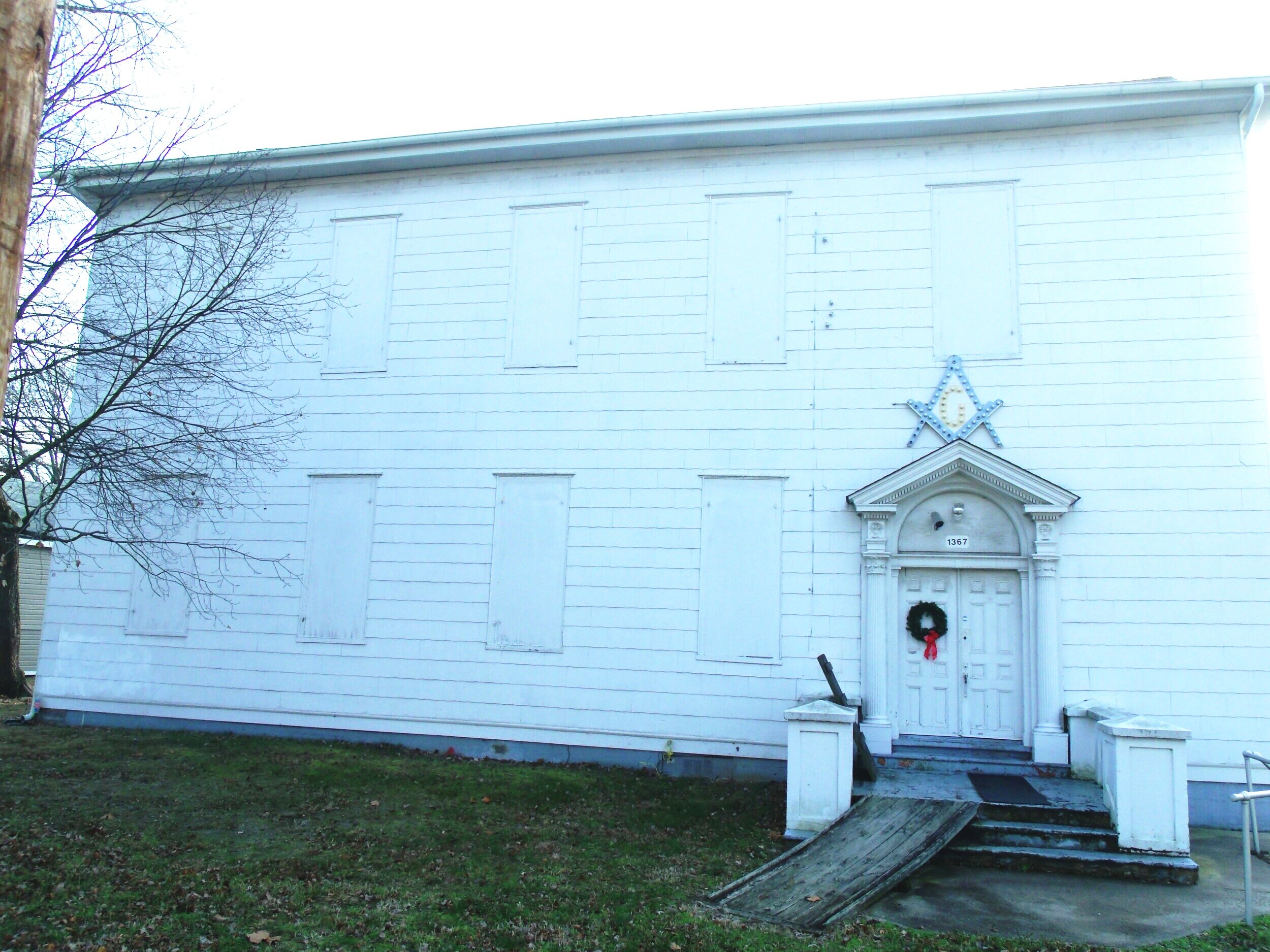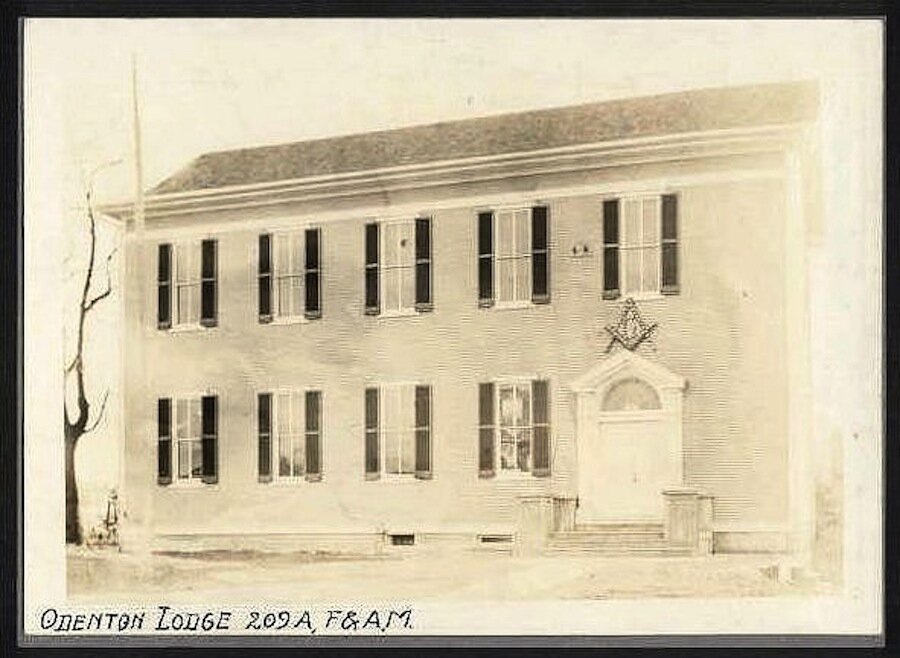Odenton’s Masonic Lodge: The Early Years
by J. Irving Waters
For nearly a century, the Odenton Lodge has been a vital part of the community and has made many contributions to the causes of Freemasonry in Maryland. The following history of the lodge was written by the late J. Irving Waters, Lodge Secretary, prior to the 50th anniversary observance in 1985.
To begin at the beginning, Odenton Lodge No. 209 was granted a charter on May 12, 1908 by the Grand Lodge of Ancient Free and Accepted Masons of Maryland. The charter was signed by Brother Thomas J. Shryock, who had at that time been Grand Master of Masons in Maryland for some 27 years.
The first officers of Odenton Lodge, with their previous affiliations, were:
Richard D. Downs, Worshipful Master, Laurel Wreath No. 149
J. Asa Warfield, Senior Warden, Howard Lodge No. 101
George L. Mankin, Junior Warden, Howard Lodge No. 101
Robert L. Bier, Secretary, affiliation unknown
John A. Watts, Treasurer, Howard Lodge No. 101
Nelson A. Ryon, Senior Deacon, Laurel Wreath No. 149
Isaac Silver, Junior Deacon, Howard Lodge No. 101
Andrew J. Disney, Tyler, Laurel Wreath No. 149
The men who formed the first nucleus of Odenton Lodge were of diverse backgrounds – a fact which has remained typical of Odenton Lodge, and which is indeed typical of Masonry, which unites men of every country, sect and opinion.
From all walks of life
Brother Downs, the Worshipful Master, had been a schoolteacher at one time, and subsequently worked for the federal government at the Customs House in Baltimore. Brother Warfield was a carpenter, builder and farmer and was primarily responsible for the construction of the lodge building. Brother Bier – usually known as “Uncle Bob” – worked at the Library of Congress and served as Sunday School Superintendent at Bethel Church, which was located within what is now Fort Meade. Brother Ryon was a physician. Brother Silver was a storekeeper and a member of the Jewish faith. These men, coming as they did from several walks of life, and differing widely even in their religious beliefs, had one very important characteristic in common: they were all Masons, and as such built their most lasting monument, Odenton Lodge No. 209, AF&AM.
A home of its own
For some time after the lodge was chartered, it met in the old school building located between the present temple and Brodsky’s Store. It was, of course, essential that the lodge build a home of its own. To that end, money was obtained from several sources. A part of the necessary amount was obtained by means of a bank loan. A number of the brethren furnished sums of money, regarding them as donations, and expecting no repayment. Much to their surprise, all of these sums were gradually repaid, until by 1920, the entire indebtedness incurred in connection with the construction of the temple had been retired, and the mortgage burned. Actual construction of the building was under the supervision of Brother Warfield, who did a great deal of the work himself. He was assisted by many of the brethren, who gave generously of their time, their skills and their aching backs. By 1912, the building was completed, and it has served well ever since.
Home away from home
Being located near a large military reservation, Odenton Lodge has enjoyed a close relationship with our Masonic brethren in the armed forces and has served as host to many Masons who were far from their home lodges. During World War I, the lodge only 10 years old at the time – raised approximately 200 candidates, of whom the majority were military personnel and about half of whom were raised as courtesies to other jurisdictions. Meetings were held three times weekly, on Monday and Wednesday nights and on Saturday afternoons. Degrees were conferred upon candidates from almost every state in the Union. Many visitors were Masons from foreign countries. Sometimes as many as 75 visitors were present at a single communication.
“Feed them”
Grand Master Shryock instructed the Worshipful Master – our present secretary, Brother J. Irving Waters, who as Master of Odenton Lodge in 1918, 1919 and 1920 to “feed them” at every meeting, and to send the bills to the Grand Lodge. His instructions were followed and every meeting was followed by a collation which might consist of everything from a hot dog to a turkey dinner, a tradition which has continued. The brethren from Fort Meade turned out by platoons to partake of the refreshment offered by this little “country lodge.” Brethren of the lodge, in turn, had the lessons of Freemasonry exemplified to them as they observed the absence of distinction among the visitors; the general and the private frequently sat elbow to elbow in the Lodge Room and at the tables. Whatever their relative positions might be in the outside world, within the special world of the lodge they were brethren and “on a level” with each other.
After World War I, Odenton Lodge continued to welcome the Masons who found themselves stationed at Camp Meade. Many of the officers and enlisted men at the post became Masons in Odenton Lodge. Many of them served as officers of the lodge, and several were honored by election to the position of Worshipful Master. As a consequence, Odenton Lodge has members scattered all over the world, and one is likely to encounter Masons who have visited Odenton wherever one goes.
Small lodge, steady growth
Odenton Lodge has never had what may be considered a large membership. In 1923, after all the accessions of World War I, we had 303 on the rolls and in that year 22 Masons were raised. By 1930, our membership had fallen to 286 and in that year we raised only one. In 1940, due to the Depression and other causes, membership had dropped to 196 and by 1942 had fallen to 186, which was a low point. During World War II, we began a steady growth, which by 1950 had increased the number on our rolls to 293. As of June this year we can count 300.
It will be noted that the history of Odenton Lodge has not been one of excitement, but rather one of quiet, unassuming service. Through its life the lodge has devoted itself to the ancient Masonic tasks of making Masons and teaching Masonry.
First in brotherhood
We refer to our order as a “fraternity” yet often forget that the word fraternity is exactly translated as “brotherhood.” The most important product of the lodge always has been brotherhood. Many sojourners, on their first visit to Odenton Lodge, have expressed something resembling astonishment at the warmth of the greeting which was extended to them by the brethren. This warmth is voluntary and natural – it is not the result of the Worshipful Master having instructed members to be sure to shake hands with the stranger within our gates. We do not believe that there can be a stranger within our gates – for no Mason can be a stranger to any other Mason. We extend to the sojourner only what is his Masonic due, recognizing him as a brother and in treating him as such. This is the basic tenet of our lodge and should be of every lodge.
Just as our membership is small, so are our material possessions of small consequence. But we are rich in all that constitutes Masonic wealth. In our lack of discord, in our relations with our sister lodges and in our devotion to what we believe to be the ideals of Masonry, we feel that we have built a structure of which we can be proud.
Relationships with Nearby Lodges
Odenton Lodge has long been part of a loose alliance of lodges in Anne Arundel County. Baseball was a common pastime among local Masons, and by the late 1940s and early 1950s, a trophy named GOAT (for Glen Burnie, Odenton, and Annapolis Triangle) was being awarded to the winner of the tri-lodge baseball tournament. Odenton frequently won it as we had a few ringers (one example is Babe Phelps, formerly an MLB catcher with the Brooklyn Dodgers). Many of the Odenton Lodge team members also worked together at the old Nevamar Plastics Plant, which previously was a significant part of the Odenton community.
Since that time, Sincerity Lodge #181 has been added to the confederation, to form the current GOATS moniker. Each year a fellowship picnic is held with all four lodges attending.
The following was reprinted from the Heritage Times, News Journal of the Odenton Heritage Society, Inc., Number 12, December 1996):
Lodge Secretaries Left Their Marks
In 1960, J. Irving Waters, the author of this article, turned over his duties as secretary of the Odenton Lodge to James H. Conboy. Waters had served many terms, beginning in about 1919, and Conboy would serve until 1995. We thought it would be appropriate to share brief biographies of these officers, whose combined tenures spanned most of the years the lodge has been in existence. We particularly wish to thank Mr. Conboy for preserving Irving Waters’ article and making it available for our news journal. We also wish to thank Ellen (McGowy) Alexander and Nancy (McGoury) Kever, Irving Waters’ granddaughters, and George Murray for their recollections of Mr. Waters’ life and career.
John Irving Waters
John Irving Waters was born near Woodwardville in 1885. In 1904, he took a job as a clerk with the Baltimore and Ohio Railroad in downtown Baltimore. In 1918, he was promoted to claims adjuster in the freight department, a position that he held for more than 30 years.
Irving Waters married Lillian Beasley in 1914, and they settled on Patuxent Road in Odenton. Every weekday, Irving walked to the train station in Odenton and rode to work on the train. In 1927, the Waters moved into the home of Thomas Beasley, Lillian’s father, at the corner of Patuxent and Odenton Roads. Today this house, located at 1391 Odenton Road, is the home of Stephen and Diane Boring. The Waters resided in this house for the rest of their lives. Irving enjoyed the big yard; he raised chickens and planted sycamore trees, and he and Lillian tended a beautiful garden that kept them supplied with produce for the table or for canning. Always kind to their friends and neighbors, they looked after elderly May Watts (Mrs. John Watts), who lived next door at 1395 Odenton Road. The Waters even welcomed “tramps” from the railroad tracks and fed them fried egg sandwiches and coffee on the back porch of their home.
When Irving Waters retired from the B&O in 1949, his co-workers auctioned his alarm clock as a gag. It was a good omen; during 26 years of blissful retirement, he relaxed, enjoyed his outdoor hobbies, worked with the Masonic Lodge and Boumi Temple, and was active in Epiphany Episcopal Church and community organizations, including the Odenton Improvement Association and Odenton Health Center. He died in 1975 at age 89.
The Waters’ daughter, Mary McGowy, became a teacher and principal in the Anne Arundel County public school system. Her husband, Thomas McGoury, was a charter member and director of the Odenton Heritage Society.
James Henry Conboy
James Henry Conboy’s parents, James Hamilton Conboy and Martha (Henry) Conboy, were born in Ireland and met in New York City. James Hamilton Conboy (James Henry’s father) maintained motor vehicles while in the United States Army, and after World War I he worked as a civilian employee in the ordnance shop at Camp Meade. In about 1921, Davis S. Ross, a local developer, built a house for the Conboys where Oakwood Road (now Oakton Road) crossed the WB&A Electric Railroad line to Annapolis. This house is still standing but is vacant.
James Henry Conboy was born in Odenton and attended Odenton Elementary School, Arundel High School, Glen Burnie High School and Strayers Business College in Baltimore. In 1939, he began working at Fort George G. Meade in the warehouse area. For almost four decades he worked in the maintenance section of the quartermaster corps, where furniture, typewriters, clothing, and other equipment at the fort were repaired. He retired in 1977 as assistant chief of his unit. In 1975 he married Eileen Clark and moved from Odenton to Harmans. He is an active member of the Odenton Masonic Lodge, which he joined in 1945.
Odenton Heritage Society
The main building of the Odenton Heritage Society Historical Center was the original meeting place of Odenton Lodge #209, AF&AM, from 1912 to 2001. Today, it serves as a local history museum and library, the Society’s office, and a gathering place for lectures, educational and cultural events, fundraising activities, and other functions that support and fulfill the Society’s mission. The Museum is open the first Sunday of the month from 1:00 pm to 4:00 pm except October, when it is open the first Saturday from 9:00 am to 2:00 pm for Odenton Day.



